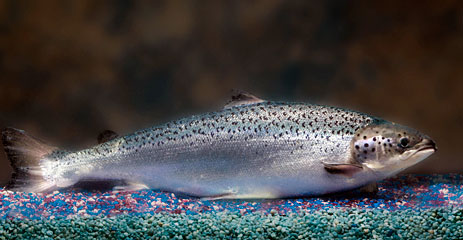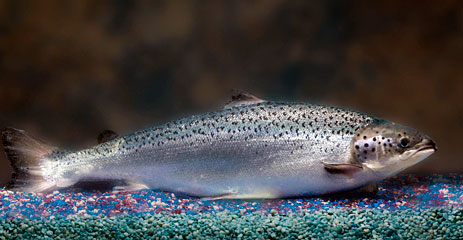 Tipping the scales: The transgenic faster-growing AquAdvantage salmon from AquaBounty.AquaBounty photoCorrected Oct. 6 due to an editing error
Tipping the scales: The transgenic faster-growing AquAdvantage salmon from AquaBounty.AquaBounty photoCorrected Oct. 6 due to an editing error
The government recently held three days of meetings about whether to approve the “AquAdvantage” salmon — genetically engineered (GE) to grow faster thanks to genes from the Chinook salmon and from the eel-like ocean pout — for human consumption. As I reported here, the FDA special committee charged with evaluating the safety of the fish seemed likely to rubber-stamp the super-size salmon.
Well, did they? And what’s next?
The New York Times first said the “Panel Leans in Favor of Engineered Salmon” but later walked that back to “Panel Advises More Aggressive FDA Analysis.” The meeting on the third day, which debated whether to label the fish as genetically engineered, ended with “No Agreement Imminent On Salmon Labeling,” concluded the Los Angeles Times. A “rough consensus” was reached by the committee that “if the fish is approved for market, consumers should have a way to avoid it.”
Somewhat surprisingly given its veterinary and pro-industry members, the committee did act more cautiously than anticipated. Here’s what really happened.
I want a new (animal) drug
Because the FDA is regulating the GE salmon as a “New Animal Drug,” in agency terminology, it convened a special Veterinary Medicine Advisory Committee (VMAC) to evaluate it. During the first two days of meetings, the FDA’s Animal Biotechnology Interdisciplinary Group presented its analysis of the science behind the AquAdvantage to the committee. (You can see the agenda here.)
The committee wasn’t being asked whether or not the FDA should approve the GE salmon. Rather, it was asked four specific questions, basically: Do the data and information demonstrate that the genes put into the salmon are safe for the salmon? Is there a reasonable certainty of no harm to humans from consumption of foods derived from AquAdvantage salmon? Do the AquAdvantage Salmon demonstrably grow faster than their conventional counterparts? Are any potential environmental impacts from AquAdvantage Salmon production adequately mitigated by AquaBounty Technologies’ proposed conditions of use?
The second question, of course, is of the most importance to consumers, as is the discussion on the third day of meetings about whether the fish should be labeled as GE if approved.
The committee members had received a 180-page briefing packet about the GE salmon, but the members of the ABIG only saw data presented during the course of the meeting. One scientist who was there told me that in several cases, the FDA selectively chose which data it presented in a way that made the AquAdvantage look better.
For example, the briefing packet shows a comparison of omega-3 fatty acids — the “good” kind of fatty acids, believed to promote healthier hearts and prevent cancer — to the less-desirable omega-6 fatty acids in five groups of salmon. Data for three of the groups were submitted by AquaBounty Technologies, the company that makes the GE salmon: salmon on commercial salmon farms (“Farm raised”), non-GE salmon raised at AquaBounty’s facility (“Sponsor control”), and the genetically engineered AquAdvantage salmon. The omega-3 to omega-6 ratios for these groups are:
- Farm-raised — 3.9
- Sponsor control — 3.2
- GE salmon – 3.6
Based on this data, the GE salmon looks pretty good. But the table in the briefing packet shows numbers that were obtained independently from scientific literature for both wild-caught and farmed salmon. That data shows farmed salmon with an omega-3 to omega-6 ratio of 4.1, and wild salmon with a staggering 10.4. [Correction made Oct. 6: The previous numbers were mistakely converted to ratios in the editing process, when the FDA packet gives them as single values.] The differences in the farmed salmon could be due to whether they are being fed their natural carnivorous diet or one heavy in grains.)
Suddenly the GE salmon doesn’t look as good — especially considering that many people eat salmon specifically for the omega-3s in them, and try to avoid foods high in omega-6s. But in the PowerPoint presented in the meeting, the data for the wild salmon was left off entirely.
Despite the ABIG’s obvious interest in approving the GE salmon, the members of the special committee had enough scientific knowledge and integrity to ask questions and look at the facts. According to Consumers Union Senior Scientist Michael Hansen, who was called to testify, the science submitted in the FDA’s briefing packet was “sloppy,” “misleading,” and “woefully inadequate,” and it appears that the committee members independently figured that out. They could not conclude definitively, they said, that “the data and information demonstrate that there is a reasonable certainty of no harm from consumption of foods derived from AquAdvantage salmon.”
Raw material deal
During the third day, the public was invited to comment on issues related to labeling the GE salmon if it is approved. In a background document on labeling, the FDA explained that in the absence of a “material difference” between a GE and a non-GE food, it does not have the legal authority to require labeling based on consumer desire alone. The document adds that genetic engineering does not constitute a “material difference” in the eyes of the FDA, defined as a feature that can be detected by one of the five senses or some physical difference such as a change in a functional characteristic or some physical quality.
Hansen challenged the FDA’s interpretation of the law, saying that the FDA has misinterpreted what the courts have said on this issue. “The law states that all ‘material’ information must be on a label, otherwise it is considered false and misleading. ‘Material’ does not depend on any physical difference; it only depends on what information is considered to be of importance to consumers,” said Hansen. In a 2008 Consumers Union poll, 95 percent of respondents wanted food from genetically engineered animals to be labeled. (Consumers Union’s public comments on GE salmon labeling are here.)
The three days of meetings provided plenty of criticism of the science used by the FDA to determine that the GE salmon is safe, as well as of the legal arguments that would dispense with labeling the GE salmon if approved. But what do the leaders at FDA, the Department of Health and Human Services, and even the White House, want? The approval of the GE salmon, as of now, could go either way.
&n
bsp;




